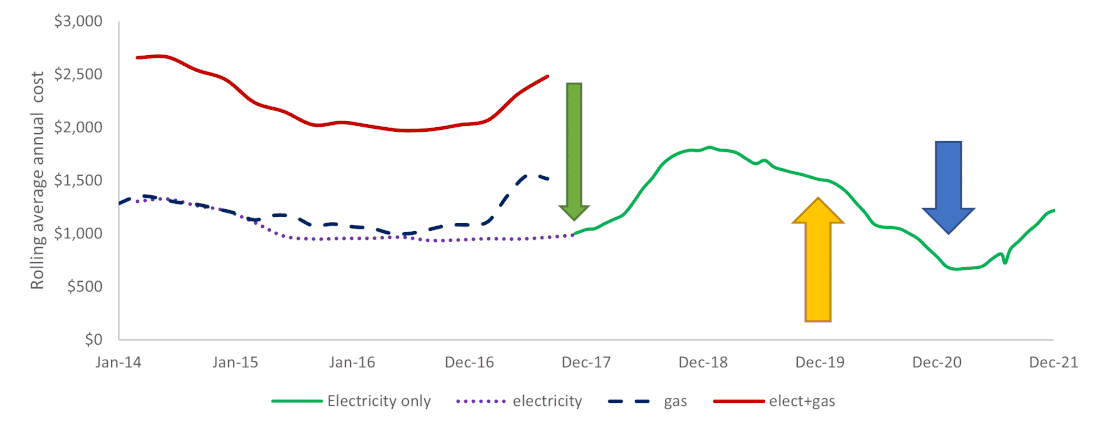Eastern Climate Action Melbourne
One personal home transition story
The chart below depicts one family's home energy transition, reducing energy bills for a family of four over 8 years, Over this period we reduced annual energy bills from over $2500 per year to around $600, depicted as a rolling annual average.
The period up to November 2017 represents living in a brick veneer house with gas ducted heating, hot water and cooking and halogen downlights. Shopping around for the best retail prices, draught-proofing doors and windows, efficient energy use including LED base standing lamps instead of halogen down lights, added up to pull the cost down about $700 (the step up in gas at the end is related to in-laws visiting from UK for eight weeks).
Then we had three key transition points, indicated by the arrows.
The period up to November 2017 represents living in a brick veneer house with gas ducted heating, hot water and cooking and halogen downlights. Shopping around for the best retail prices, draught-proofing doors and windows, efficient energy use including LED base standing lamps instead of halogen down lights, added up to pull the cost down about $700 (the step up in gas at the end is related to in-laws visiting from UK for eight weeks).
Then we had three key transition points, indicated by the arrows.
In November 2017 we moved into our renovated, all-electric, energy efficient home. With good solar light and warmth from floor to ceiling windows facing north, the thermal focus of the renovation included
- Thermal shell: ceiling insulation (Total R value of 5); underfloor insulation (R2.5 + removal of old floor ducts); wall insulation (R2.5 insulation to exposed wall cavities, pump in wall insulation to remainder of walls)
- Double glazing all existing and new windows.
- Draught Proofing: of doors, windows, wall vents and gaps and cracks as required.
- Shade cloth over the courtyard pergola to passively control solar heating load in summer.
- Disconnection from reticulated gas and all-electric appliances including heat pump hot water, heat pump heating/cooling and ceiling fans, induction cooking and electric oven.
- Natural and efficient lighting including removing the courtyard pergola roof (opening sky view) triple glazed solar skylights in enclosed rooms, and LED lighting.
|
In January 2020 we installed 6.6kV solar system including data monitoring. Using our own energy e.g. switching the heat pump hot water to daytime, reduced our network energy bill to around $600.
In January 2021 we purchased a EV, so we now have transport costs added into our household energy costs. It costs about $5 to fill an EV “tank”. Of course car charging is free using our solar, as shown to left with our solar following car charger. In July 2021 the solar feed in tariff reduced from 9c to 6c per kWh, so the saving against consumption tariffs is worse. More than ever the incentive to use our own energy, maybe it is time to investigate a home battery? |


